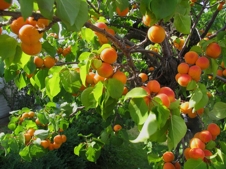| Perennial / Desiduous Trees / APRICOT FRUIT TREE FLOWERING Prunus Mandshurica |
|
|
|
|
| |
|
Plant name - Apricot
|

|
|
 |
|
 |
| Common name - Prunus
|
| Plant type - Desiduous |
| Vegetation type -
Perennial |
| Growth rate - Medium |
| Leaf / Flower color
- Green / Pink |
| Other names - Prunus armeniaca, Prunus brigantina, Prunus mandshurica
|
| |
| Description : |
An apricot is a fruit or the tree that bears the fruit. Usually, an apricot tree is from the tree species Prunus armeniaca, but the species Prunus brigantina, Prunus mandshurica, Prunus mume, and Prunus sibirica are closely related, have similar fruit, and are also called apricots.
The apricot is a small tree, 8–12 m (26–39 ft) tall, with a trunk up to 40 cm (16 in) in diameter and a dense, spreading canopy. The leaves are ovate, 5–9 cm (2.0–3.5 in) long and 4–8 cm (1.6–3.1 in) wide, with a rounded base, a pointed tip and a finely serrated margin. The flowers are 2–4.5 cm (0.8–1.8 in) in diameter, with five white to pinkish petals; they are produced singly or in pairs in early spring before the leaves.
The fruit is a drupe similar to a small peach, 1.5–2.5 cm (0.6–1.0 in) diameter (larger in some modern cultivars), from yellow to orange, often tinged red on the side most exposed to the sun; its surface can be smooth (botanically described as: glabrous) or velvety with very short hairs (botanically: pubescent). The flesh is usually firm and not very juicy. Its taste can range from sweet to tart. The single seed is enclosed in a hard, stony shell, often called a "stone", with a grainy, smooth texture except for three ridges running down one side.
.
|
| |
| Growing Instructions : |
* Crack the dried apricot pits open with a nutcracker or a hammer. Take care not to damage the almond-shaped seed inside each pit.
* Place the seeds in a dish of room-temperature water and allow them to soak overnight. The next day, place them in a jar or container with potting soil that is slightly damp. Cover the jar or container.
* Put the jar or container in the refrigerator to mimic the effects of a cold winter. Check the jar after a month to see if any roots have sprouted. Apricots typically take four to six weeks to sprout, according to Mother Earth News.
* Plant the sprouts if it's a month before the typical last frost date in your region; otherwise, keep them in the refrigerator a while longer. When it's time to plant, fill cleaned yogurt containers or milk cartons with a high-quality potting soil. Plant the sprouts in these containers and place them in a sunny area of your house.
* Plant your apricot seedlings in the garden when the danger of frost is past. Choose a sunny site with well-drained soil that has a neutral pH -- add lime if a soil test indicates a low pH. Plant each seedling in a 3-foot-tall mound if the soil in your garden usually stays wet after it rains. For best pollination, plant your apricot seedlings near other varieties of apricots.
|
| |
|
|
|
|
|
 |
|
